Strategies for Capturing Groundhogs: Effective Baiting Techniques


Intro
Groundhogs, also known as woodchucks, can be particularly troublesome for homeowners and gardeners. These burrowing creatures often disrupt landscapes, damage plants, and compromise garden productivity. Understanding effective strategies for trapping them is essential for those looking to maintain their yards effectively.
This article delves into practical baiting techniques for groundhog trapping. The information is tailored to those who seek sustainable pest management. Knowledge of groundhog behavior, combined with the right bait, increases capture success and can deter future pests.
Understanding Pests
Definition of Pests
Pests are organisms that cause harm to crops, gardens, and property. Groundhogs fall into this category as they can damage root systems, feast on vegetables, and create unsightly mounds in lawns. Identifying these pests is vital for implementing control measures.
Importance of Pest Identification
Proper pest identification is critical when addressing any infestation. Groundhogs can be mistaken for other wildlife, leading to ineffective management decisions. A clear understanding of their habits, such as their active times and preferred foods, will guide the selection of appropriate bait and traps. Recognizing differences between groundhogs and other rodents ensures homeowners can apply the most effective strategies for control.
Prevention Techniques
Home and Garden Preventative Measures
Preventing groundhog invasions starts with securing the property. Several steps can be taken:
- Fencing: Install a sturdy fence around gardens, ensuring it extends underground to prevent burrowing.
- Securing Food Sources: Remove any fallen fruits, vegetables, or pet food that may attract groundhogs.
- Maintaining Landscape: Keep grass trimmed and clear debris that might serve as shelter for these pests.
Seasonal Prevention Tips
Groundhogs are most active during spring and summer. Therefore, seasonal strategies include:
- Spring Cleaning: Clear out potential nesting areas. This makes the property less appealing.
- Autumn Preparations: As the cold months approach, check for burrows and take preventative actions to avoid winter infestations.
Eco-Friendly Pest Control Solutions
Overview of Sustainable Practices
Sustainability in pest control promotes methods that minimize harm to the environment. For groundhogs, live traps allow for relocation without killing the animal. Additionally, maintaining a healthy ecosystem can deter groundhogs naturally. This can include encouraging the presence of natural predators in the area.
Natural Remedies and Their Effectiveness
Various natural remedies can discourage groundhogs from invading gardens. Consider these methods:
- Strong Scents: Garlic, hot pepper, and castor oil can deter groundhogs when applied around garden borders.
- Human Hair: Spreading hair clippings around the garden may confuse groundhogs, making them feel there are predators nearby.
Natural solutions not only provide eco-friendly pest management but can also be effective in keeping these pests away.
Preamble to Groundhog Trapping
Groundhogs, also known as woodchucks, can pose significant challenges for homeowners and gardeners. They typically create burrows that can undermine plant growth and landscape integrity. Effective groundhog trapping is crucial, not only for protecting gardens but also for ensuring ecological balance in the area. This article delves into the strategies and techniques necessary for successful groundhog trapping, focusing particularly on baiting methods that enhance capture rates.
By understanding groundhog behavior and habitats, one can develop more targeted trapping strategies. Groundhogs are predominantly herbivores and have specific food preferences, a factor that plays a vital role in choosing the right bait. With the right approach, trapping these animals can become a manageable task instead of a nuisance, allowing garden spaces to remain unharmed and flourishing.
Understanding Groundhogs
Biology and Behavior
Groundhogs display distinct biological features and behaviors that inform trapping strategies. As members of the rodent family, their strong incisors grow continuously, prompting them to gnaw on various materials, including vegetation. This trait significantly influences their foraging behavior, leading to consistent feeding patterns focused around specific food sources. Knowing their preferences assists in selecting bait that will attract them effectively.
Key Characteristics: Groundhogs are primarily diurnal, meaning they are active during the day. They typically emerge from their burrows early in the morning or late afternoon to forage. Understanding this behavior allows traps to be set at optimal times, improving the likelihood of capturing these animals.
Unique Features: Groundhogs possess keen senses, particularly smell, which they rely on to locate food. This feature supports the idea that bait with strong odors, such as fresh fruits or vegetables, will yield better results in trapping efforts. However, their natural wariness can pose challenges in luring them effectively, necessitating careful placement of bait within traps.
Habitat and Distribution
The habitat of groundhogs significantly affects their foraging and burrowing activities. They prefer open areas with ample vegetation, often seen in suburban gardens and farmland. Their burrows can create extensive underground networks that can compromise local flora.
Key Characteristics: Groundhogs are found primarily in North America, favoring areas that provide shelter and food sources within proximity. This distribution is advantageous for gardeners as it means that their presence can often be predicted based on environmental conditions and vegetation type.
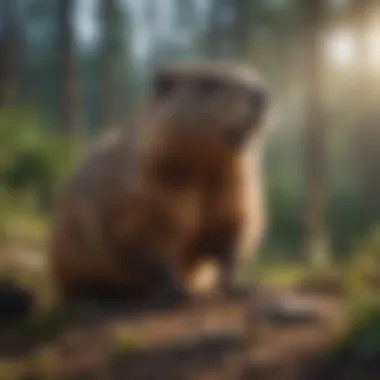

Unique Features: While groundhogs may seem harmless, their burrowing activities often lead to structural problems for homes and landscaping. Recognizing these issues early through behavioral observations can help in managing their populations effectively. Knowledge about their distribution assists in determining likely areas where traps should be placed for maximum effectiveness.
Importance of Trapping
Impact on Gardens and Landscaping
The importance of trapping groundhogs extends beyond mere nuisance control; it is crucial for the health of gardens and overall landscaping. These pests can cause significant damage by consuming vegetables and flowers, leading to unsatisfactory yields. Their burrowing practices can destabilize soil, affecting the root systems of other plants.
Key Characteristic: Trapping prevents further damage by removing groundhogs from problematic areas. Homeowners can protect their investments in gardens and landscaping without resorting to harmful pesticides or chemicals, promoting a healthier ecosystem.
Unique Feature: Groundhog populations can rapidly increase if not managed. A small number of groundhogs can quickly escalate into a larger issue, resulting in more extensive landscaping damage. Thus, consistent trapping becomes necessary to maintain both garden health and aesthetic appeal.
Ecological Considerations
Understanding the ecological significance of trapping is essential. Groundhogsplay a role in their ecosystems, and their removal should be conducted thoughtfully. While they can damage gardens, they also contribute to soil aeration through their burrowing activities.
Key Characteristic: Trapping should not be done impulsively, as it can disrupt local wildlife balances. Consideration should be given to potential impacts on predatory species that rely on groundhogs for food.
Unique Feature: Sustainable trapping practices, including relocation options, can help mitigate adverse effects on the environment. Being aware of local regulations regarding wildlife control ensures that actions taken are legally compliant and ecologically sound.
Selecting the Right Trap
Choosing the correct trap is essential for effective groundhog capture. Utilizing the right type ensures higher success rates, enhancing not just the efficiency of the trapping process, but also the safety of the operation. A suitable trap aligns with the size and behavioral traits of groundhogs, maximizing the likelihood of a successful catch while minimizing distress to the animal. Understanding the options available will prepare homeowners for a more strategic approach in managing these pests.
Types of Traps Available
Live Traps
Live traps are a popular option for capturing groundhogs. These devices allow for safe and humane capture without harming the animal. The main characteristic of these traps is their ability to confine the animal without injury, enabling later relocation. This aspect is beneficial for those who prefer non-lethal management methods.
One unique feature of live traps is the locking mechanism, which triggers when the groundhog enters, preventing escape. This mechanism provides an advantage by increasing the probability of capture. However, a disadvantage is that it requires regular monitoring to ensure the trapped animal does not suffer undue stress.
Kill Traps
Kill traps, on the other hand, serve a different purpose. They are designed to swiftly eliminate the animal upon capture. The defining characteristic of kill traps is their efficacy in quickly neutralizing groundhogs, making them a viable option for widespread infestations. Homeowners may prefer kill traps to reduce the invader population rapidly.
A unique feature of these traps is their design, often spring-loaded, ensure immediate action when triggered. This efficiency can be advantageous in reducing the number of groundhogs effectively. However, these traps come with ethical considerations, as they result in the animal's death, which may not align with every homeowner’s values.
Choosing the Appropriate Size
Selecting the correct size of the trap is critical for success. A trap that is too small may fail to engage or accommodate the groundhog, while one that is too large may not provide the necessary security. Ensuring the dimensions match the size of potential captures increases efficiency in trapping.
Dimensions and Specifications
Dimensions play a vital role in trapping effectiveness. Groundhogs are relatively large rodents. Therefore, traps must meet specific size requirements for optimal capture. Typically, live traps should measure at least 24 inches long to ensure a comfortable fit for the animal.
Another important aspect of specifications includes the trap's gauge and materials used, which affect durability. Durable materials can withstand outdoor conditions, giving them an edge in long-term use. These specifications are particularly important for homeowners who desire a lasting solution without frequent replacements.
Trap Sensitivity
Trap sensitivity defines how easily a trap can be activated. This aspect is crucial for ensuring that groundhogs, upon entering the trap, trigger the mechanism immediately. Traps that offer adjustable sensitivity provide homeowners with the flexibility needed to accommodate different behaviors of groundhogs. Some animals may be cautious, requiring a more sensitive setting to ensure successful capture.
A unique feature is the option to customize the settings depending on the environment. For example, in areas with frequent disturbances, a more sensitive trap can facilitate effective capturing. However, if overly sensitive, it may non-selectively catch unintended animals, which could be a drawback for some users.
Effective Baiting Techniques
Effective baiting techniques are crucial for successfully capturing groundhogs. Groundhogs, also known as woodchucks, are herbivorous rodents that can cause significant damage to gardens and landscaping. Understanding how to utilize bait effectively can make a substantial difference in your trapping results. The right bait not only attracts groundhogs but also helps ensure they enter the trap. Using appropriate techniques will maximize your chances of a successful capture.
Types of Bait
Vegetable Options
Vegetable options provide a strong lure for groundhogs due to their natural diet. Groundhogs typically consume a variety of plants, including leafy greens and root vegetables. Key vegetables to consider include lettuce, carrots, and sweet corn.
These choices are particularly beneficial as they appeal to the groundhog's instinctual feeding behavior. For instance, lettuce's high water content may attract a thirsty groundhog.
However, while vegetables are an effective bait choice, there are some disadvantages to consider. Vegetables can spoil quickly, especially in warm weather, and this can lead to reduced effectiveness if not monitored properly.
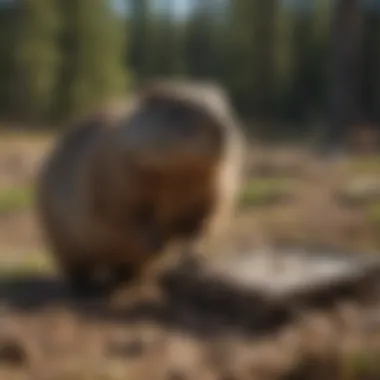
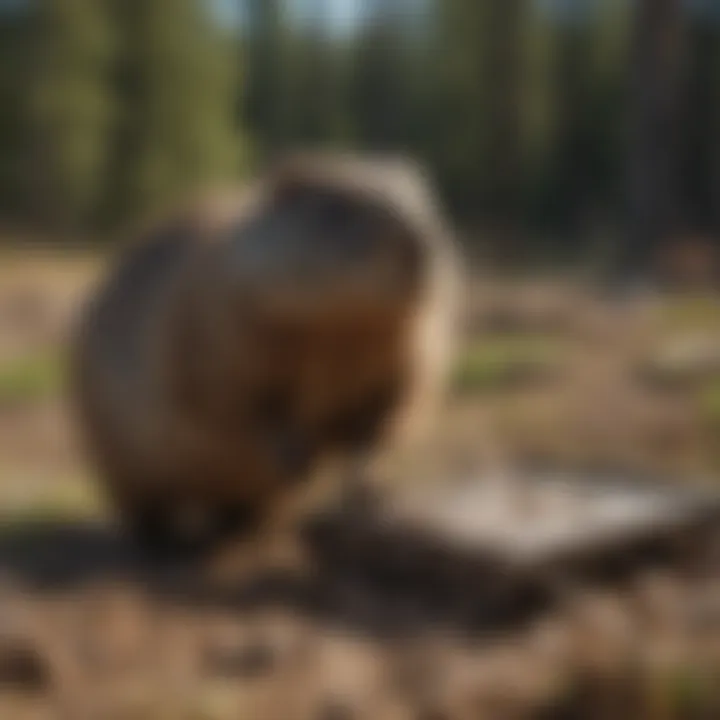
Fruits and Nuts
Fruits and nuts are another appealing bait option for groundhogs. Sweet fruits like apples, peaches, or strawberries can be incredibly attractive due to their scent and high sugar content. Nuts, such as sunflower seeds and walnuts, also serve as a strong lure.
The unique feature of fruits and nuts is their ability to draw groundhogs over a longer distance than vegetables. Groundhogs may sense the strong aroma of fruits from afar, prompting them to investigate the area.
On the downside, fruit may attract other animals as well, which could complicate your trapping efforts. Additionally, if a fruit becomes overly ripe, it might not be as enticing, thus losing its effectiveness.
Bait Placement Strategies
Location of the Trap
The location of the trap is a crucial factor in baiting success. Placing traps near groundhog burrows or pathways they frequently use increases the likelihood of capture. Groundhogs tend to follow established trails to reach food sources, so positioning traps along these routes is beneficial.
By doing so, you make it easier for the groundhog to encounter the bait. Additionally, providing ample cover can improve your chances, as it makes the trap feel safe for the animals. A significant advantage is that a well-placed trap can yield results without scaring off the target.
How to Secure Bait
Securing bait properly in your trap is essential for ensuring that the groundhog engages fully with the bait. It is important to ensure the bait does not fall out or become easily accessible to other animals. Using wire or string to tie the bait securely in place can prevent this.
This method allows you to maximize the chances of the groundhog triggering the trap. A well-secured bait also ensures that the animal must commit to accessing it, increasing the likelihood that it will fully enter the trap. Furthermore, a solid bait setup can deter birds or small animals from stealing your bait, keeping it available for the target species.
Proper bait placement and securing techniques are top priorities for effective trapping.
Using groundhogs’ natural preferences for bait, alongside strategic placement, enhances the efficiency of your trapping process.
Timing and Monitoring
Effective trapping of groundhogs is not merely about setting a trap and choosing the right bait; it is also significantly about the timing and monitoring. Understanding when to trap and how to supervise the process can greatly influence the success of your efforts. This section addresses the importance of timing and monitoring in groundhog trapping, defining essential elements, benefits, and considerations.
Best Times to Trap
Seasonal Considerations
The seasonal pattern of groundhog behavior is crucial to understanding when to set traps. Groundhogs are most active during spring and summer, as they emerge from hibernation and search for food. Trapping in these seasons increases your chances of success, as groundhogs tend to frequent their foraging patterns. Adapting to seasonal changes allows you to tailor your trapping activities accordingly.
One key characteristic of seasonal trapping is its alignment with groundhog reproductive cycles. In spring, females are pregnant, which can influence their feeding habits. This understanding makes spring a particularly favorable time for setting traps. However, one must consider that environmental conditions, such as heavy rains or unpredictable weather, can impact groundhog activity.
Time of Day
The time of day also plays a significant role in capturing groundhogs efficiently. Groundhogs are diurnal, meaning they are primarily active during daylight hours. Therefore, setting traps early in the morning or late in the afternoon can yield higher success rates. These times align with their natural behavior to feed and forage.
The unique feature of timing traps at these periods is the increase in groundhog visibility. They are more likely to be out when visibility is good and predators are less active. However, it is essential to monitor local wildlife, as other animals might interfere with traps during these busy feeding times.
Monitoring the Trap
Regular Check-Ins
Regular check-ins are an essential aspect of groundhog trapping. Consistent monitoring can help you determine whether your trapping strategy is working. It reduces the chances of groundhogs remaining in traps for extended periods, which is important for humane considerations. Checking traps at least once a day, and more frequently in warm weather, is ideal.
The key characteristic of regular check-ins is the opportunity to adapt your strategy. If a trap has not had any captures, you can adjust bait or trap placement more promptly. Timely visits may also help you take better care of the situation should you capture an animal, ensuring it does not suffer unnecessarily, which aligns with humane trapping practices.
Signs of a Successful Catch
Identifying signs of a successful catch is equally important. Observing indicators, such as disturbed bait or trap movement, can inform you when a groundhog has been captured. Additionally, groundhog behavior often leaves clues; for instance, if the area around the trap is heavily disturbed, it may imply an animal's unsuccessful attempt to escape.
These signs provide critical insights into your trapping effectiveness. Understanding the unique features, such as the arrangement of bait and trap mechanics, will help you assess whether modifications are necessary for future attempts. Frequent assessment of these signs can improve trapping outcomes significantly.
Effective timing and meticulous monitoring are indispensable in groundhog trapping. These strategies enhance both catch rates and humane treatment of captured animals.
After the Capture
After capturing a groundhog, there are important steps to follow. Understanding what to do next is crucial for responsible treatment of the animal and ensuring compliance with local regulations. This phase covers how to handle the captured groundhog, transport it safely, and consider options for release. Each step has specific considerations that can affect both the animal and the person in charge of the process.
Handling Captured Groundhogs
Safety Precautions
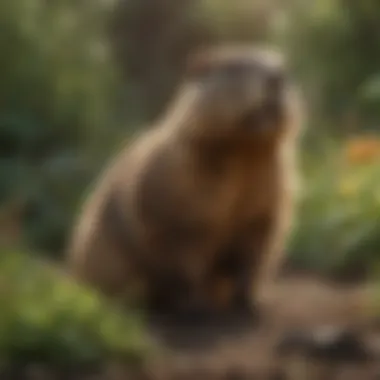
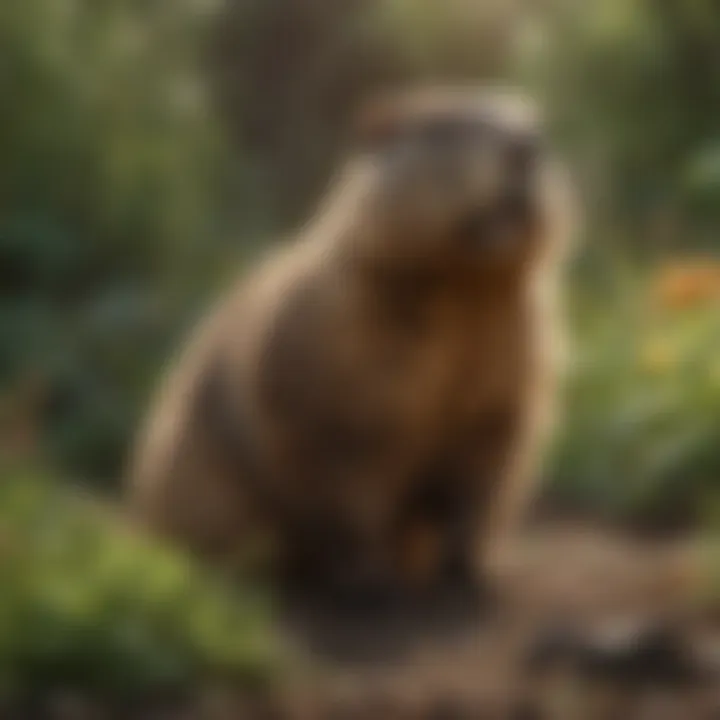
Handling a trapped groundhog requires significant attention to safety. Groundhogs, when trapped, can be frightened or stressed. They may try to escape, which can lead to them biting or scratching. Therefore, using gloves when dealing with traps is highly advisable. This keeps your hands safe from potential bites and also reduces the risk of human scent transferring onto the trap or the animal.
The key characteristic of safety precautions is the focus on minimizing stress for both the animal and the handler. Such considerations are beneficial because they ensure a more humane approach to animal control. A unique feature of these precautions is the usage of specialized handling tools, such as trap covers, which help protect the handler while maintaining the animal’s comfort. Neglecting these safety measures can lead to unnecessary injury for the groundhog or the person.
Transporting the Animal
Transporting a captured groundhog requires careful thought. After capture, it is essential to move the animal to a suitable location without causing it panic. The key characteristic of transporting the animal lies in choosing a secure, comfortable enclosure. Using a sturdy, well-ventilated trap is a beneficial choice because it keeps the animal contained during the journey.
A unique feature of transporting the animal is recognizing the importance of minimizing movement. Abrupt movements can lead to stress and possible escape attempts. Disadvantages of improper transport include making the groundhog more agitated, thus increasing the risk of injury. Proper handling is vital to achieving a successful transfer.
Release Options
Finding Suitable Locations
Finding a suitable location for release is essential to ensure the groundhog can thrive without causing further issues. A key characteristic of this process is the need for natural habitats that are away from human dwellings. This creates a beneficial situation where the groundhog can find food and shelter without impacting gardens or landscaping further.
A unique aspect to consider is determining the distance for relocation. Generally, it's advised to relocate the animal at least 5-10 miles from where it was captured. This consideration can prevent the animal from returning. Advantages of well-chosen locations are clear; suitable habitats support wildlife while addressing pest control.
Legal Considerations
Legal considerations are vital in the aftermath of capture. Understanding local laws regarding wildlife is crucial. Many areas have regulations regarding the trapping and relocating of groundhogs, which can influence choices made after capture. The key characteristic of these considerations is ensuring compliance with wildlife protection laws, reflecting responsible citizenship.
One unique feature of these legal frameworks is that they often specify where it is permissible to release groundhogs. Ignoring these laws could lead to fines or other legal ramifications. Thus, it is necessary to research and respect the local wildlife regulations. The advantages of adhering to legal guidelines are significant: it promotes ethical wildlife management and supports conservation efforts.
Remember: It's always a good approach to check local wildlife regulations before proceeding with trapping and releasing groundhogs.
Preventing Future Issues
Preventing future groundhog issues is crucial for any homeowner or gardener who has faced the challenges of groundhog interference. Once these animals have established a presence, they can quickly adapt and thrive, leading to repeat visits. Effective prevention techniques can minimize the chances of future encounters, ensuring gardens and landscapes remain unspoiled.
Exclusion Techniques
Fencing Solutions
Fencing is a direct and effective method to keep groundhogs at bay. A well-constructed fence can deter these animals from entering specific areas, particularly gardens and flower beds. It is essential that the fence is at least three feet tall and buried at least one foot underground to prevent groundhogs from burrowing underneath. The key characteristic of fencing lies in its physical barrier which can be made from materials like wire mesh or wooden boards.
Fencing is popular because it offers a long-term solution to the problem of groundhogs. Unlike baiting or trapping, which only address current populations, fencing actively prevents new groundhogs from taking residence. One unique feature of this solution is its permanence; once installed correctly, it requires minimal maintenance. However, there can be disadvantages, such as the cost of materials, aesthetic impact on the landscape, and the potential need for repairs over time.
Plant Selection
Choosing the right plants for your garden can also serve as a method of prevention. Certain plants can naturally repel groundhogs and discourage them from establishing themselves nearby. For example, strongly scented herbs like mint and lavender are known to be less appealing to groundhogs. This aspect of plant selection emphasizes how the choice of flora can directly influence animal behavior in your gardening space.
This method is beneficial as it aligns with the principles of ecological gardening, promoting biodiversity and sustainability. The unique feature of this approach is its dual benefit: not only does it help keep groundhogs away, but it also enhances the overall aesthetic and diversity of the garden. However, there can be limitations. Some repellant plants may require specific growing conditions, and it can take time to establish a full barrier against groundhogs through careful planning and selection.
Sustainable Practices
Habitat Modification
Modifying the habitat surrounding your property can create an environment unsuitable for groundhogs. Removing brush piles, tall weeds, and debris can eliminate essential cover that groundhogs seek for shelter. This method not only reduces the attractiveness of your property to these animals but also encourages a healthier ecosystem for beneficial wildlife.
The key characteristic of habitat modification is its focus on altering conditions rather than targeting the groundhogs directly. This technique is favored as it respects the balance of local ecology, promoting a sustainable way to manage not just groundhogs but other pest species as well. However, it requires ongoing effort to maintain and monitor the habitat changes.
Natural Deterrents
Utilizing natural deterrents is another effective strategy for preventing groundhogs from invading homes and gardens. Substances like cayenne pepper or castor oil can be applied around the perimeter of the garden to create an unpleasant environment for groundhogs. The key characteristic of natural deterrents is that they are non-toxic, posing no risk to local wildlife or pets while providing a repelling effect.
Natural deterrents are becoming increasingly popular because they offer an environmentally friendly solution in pest management. This unique feature ensures that they align well with sustainable gardening practices. However, one must apply these deterrents regularly, as weather and other environmental factors can reduce their effectiveness over time.
By following these prevention strategies, homeowners can tackle the challenges posed by groundhogs more effectively, reducing the likelihood of their return and protecting their gardens in a sustainable way.
The End
In this article, we explored various aspects of effectively capturing groundhogs, emphasizing the importance of proper baiting techniques. Successfully trapping groundhogs involves understanding their behavior, selecting the right bait, and employing strategic approaches to maximize capture efficiency. Each element discussed plays a critical role in ensuring that the process is effective, humane, and sustainable.
Recap of Key Points
- Understanding Behavior: Groundhogs are primarily herbivores with specific feeding preferences. Recognizing their diet helps in selecting appropriate bait, ultimately increasing catch rates.
- Types of Bait: The choice of bait is crucial. Options like vegetables, fruits, and nuts appeal strongly to groundhogs. Each type of bait can be effective depending on the season and local flora.
- Bait Placement: The location of the trap and the way bait is secured are vital. Proper placement increases the likelihood of a successful catch by aligning with the groundhog's natural movement patterns.
- Timing and Monitoring: Being aware of the best times to trap along with consistent monitoring of traps ensures that captured groundhogs are addressed promptly.
Final Thoughts
Trapping groundhogs requires thoughtful strategies tailored to their unique behaviors and habitat. While it may seem challenging at first, employing the techniques discussed can lead to improved success rates. Understanding the balance between effective baiting and humane capture methods also reinforces responsible pest management. We encourage homeowners and gardeners to adopt these strategies not just to resolve current groundhog issues but to promote long-term sustainable practices in managing wildlife interactions.
By leveraging these insights, you will not only address immediate concerns but also foster a more harmonious relationship with your garden's ecosystem.



